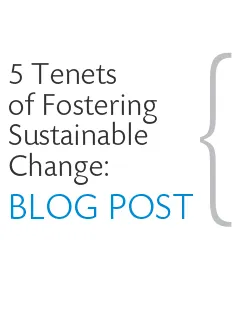Change. This simple word has been used to create communities, build businesses, and promote adoption within a myriad of other actionable objectives. It is as common as the air we breathe and as revolutionary as any invention. Yet in all of its grandeur, it has incessantly stumped many businesses and individuals along the way.
Software has taken a front seat in several organizations. It has become the core to any business, and change initiatives have sprouted and evolved to provide better solutions, be they faster, smarter or more affordable. Furthermore, for those organizations that adapt to change well and continue to sustain said changes and evolve over time, the rewards are exponential and in many cases, lasting.
As new companies emerge in markets offering innovative solutions that can ultimately disrupt the market, those organization that cannot and or will not adapt and change, and perhaps more importantly, sustain change will lose. As a result, software development teams are adopting agile development techniques to shorten development times, decrease risk, all whilst developing solutions to become more responsive to the needs of the business.
What is Sustainable Agile Change?
At Ivar Jacobson International, we understand that sustainable change is about achieving consistent and lasting adoption of agile techniques across an entire organization. This includes broad communities of people and practices.
These techniques can be broken down into five tenets: Practice Hubs, Coaching Hubs, Communities of Practice, Recognizing and Measuring Achievement, and Measuring Performance Improvement.
Practice Hubs
A practice is a repeatable approach to achieve something specific, and will have some way to organize its information. Practices come from common industry practice, or the teams themselves and can evolve to include a team’s experiences over time.
A practice-based approach allows professionals to assess and access a composition of knowledge from a library of practices, thus facilitating a repeatable approach, while flexibility is achieved by composing the appropriate practices for particular types of work.
Coaching Hubs
A coach is an integral part of any practice. Much like a football team will achieve greater results with a good coach, agile software development teams and organizations will benefit with guidance and direction while adopting and improving their agile methods and practices. Coaching Hubs allow teams to build their capabilities provided by the Practice Hubs. Training and agile coach techniques can get help to foster sustainable change.
An internal coach helps communities navigate new software and existing software seamlessly. Furthermore, internal coaches decrease the need of long-term consultants by developing initiatives that promote long-lasting values and practices no matter how far software evolves.. The Coaching Hubs help establish agile capability in product lines and development teams, and this will then seed the building of communities.
Communities of Practice
It is a community that builds and sustains a business. Each community has individuals with varying levels of skills and knowledge. It is in these communities that sustainable change can be reached. Like an ecosystem, there are those that create initiatives, those that champion initiatives, those who master, those who practice, and finally, those who participate. When each group is contributing to the matrix, the wheel of sustainable change can turn.
In short, communities set out to improve, simplify, and facilitate evolving ways of working. This makes for self-sufficient employees, which, in turn, creates an agile and lean-thinking company culture.
Recognizing and Measuring Achievement
Sustainable change has its checks and balances as well as its achievements. For the wheel of sustainability to continue its path, it must have well-oiled spokes.
Agile software is known as “creating great software.” Likewise, workplace accreditation is used to help create “great people and teams” (Refer to “Communities of Practice” above). Accreditation acts as a checks-and-balances model by uplifting individual and collective adoption and morale by providing measurable goals and achievements in the beginning phases of Change Initiatives and into future initiatives as well.
The measurement of achievement, coupled with recognition, covers every individual and team within an organization. It rewards those with existing skills while increasing the wants of individuals to improve their skills and to learn new ones. These can manifest in the form of certifications, badges, titles, and career advancement.
Measuring Improvement
In order for this initiative to work, there must be benchmarks set to measure improvement. Otherwise, there will be checks, but no balances.
It is also important that improvements are measured with tangible evidence. These metrics should be available to everyone to highlight improvement and areas of concern. When everyone is informed of the changes, whether negative or positive, the sustainable change initiative can work at its peak. At IJI, we take an approach to the rewards change through benefits and outcomes. These measurements are broken down into four categories: Better, Faster, Cheaper and Happier.
Fostering Sustainable Change
All too frequently, external consultants are invited to organizations to share their expertise in a variety of areas. But once they have gone, those same skills and practices are forgotten, and many employees and executives alike revert back to their previous ways. This cycle of refreshing initiatives can stunt employee and organizational growth.
To sustain change, there needs to be a clear initiative that starts at the practice stage, rounds out with collaboration, and measures the results of change to improve as organizations evolve.
To learn more about sustainable change, download our whitepaper.

